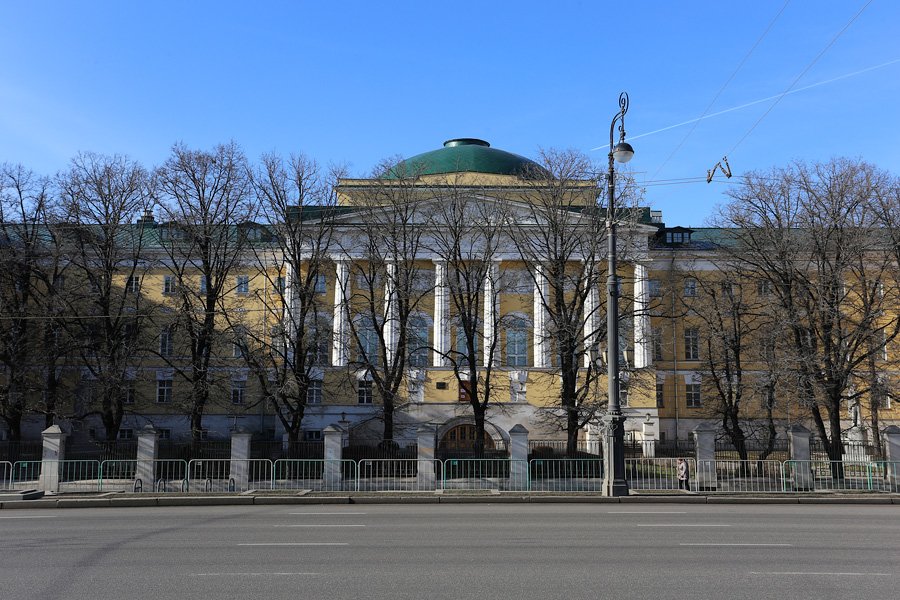О Московском Университете, как правило, говорят, что он расположен на Воробьёвых горах. Это правда, но лишь отчасти: его историческая часть находится на Моховой улице. Массивное здание с крупным куполом и широким портиком хорошо заметно с Манежной площади.
Созданный в 1755 году Императорский Московский Университет сначала разместился в здании Главной аптеки на Красной площади (до аптеки там был Земский приказ, а сейчас на его месте Исторический музей), потом переехал в бывший дом князя Репнина на Большой Никитской. Наконец, в 1782 – 1793 годах по проекту знаменитого архитектора М.Ф. Казакова на Моховой улице для университета было возведено новое здание. Его главный корпус, расположенный в глубине владения, был выделен восьмиколонным портиком и увенчан невысоким куполом над полуовальным парадным залом. Парадный двор обрамляют боковые крылья со скруглёнными наружными углами.
В 1812 году перед вступлением французов в Москву преподаватели и студенты университета были эвакуированы в Нижний Новгород, часть имущества также была вывезена. 6 сентября в здании университета вспыхнул пожар, в результате которого здание серьёзно пострадало. Всё, что не было эвакуировано, оказалось предано огню, в том числе существенная часть университетской библиотеки, насчитывавшей 20000 томов. После пожара университет посетил главный интендант французской армии маршал Дюма.
После ухода французов начался процесс приведения здания в порядок. Профессора обратились с открытым воззванием к обществу о помощи: в результате сумма пожертвований частных лиц на восстановление университета составила около миллиона рублей. Библиотека была не только восполнена, но и расширена, появились химический и анатомический кабинеты, гербарий.
Восстановление главного здания продолжалось до 1819 года. Руководил работами над московским университетом архитектор Доменико Жилярди. В целом он сохранил структуру старого здания и дворовый фасад Казакова, но на парадном фасаде заменил ионический портик дорическим, придав ему большую монументальность, и добавил рустованный цоколь с львиными масками над окнами. Также был переоформлен Актовый зал и появились солнечные часы на фасаде правого бокового крыла, созданные, по некоторым предположениям, скульптором И.П. Витали.
В советскую эпоху здание практически не изменило своего внешнего облика, лишь двуглавого орла во фронтоне сменил орден Ленина. Сам же университет утратил статус Императорского, зато получил имя одного из своих основателей – М.В. Ломоносова, а его руководство и большая часть факультетов переехали в новый комплекс зданий, построенный в 1949 – 1953 годах на Воробьёвых горах. В старом здании университета сейчас находится часть факультетов и библиотека.
Imperial Moscow University was founded in 1755 and at first located in the premises of the Main pharmacy at the Red Square (Zemsky order was in that building before to the pharmacy, and now Historical Museum is there), then moved to the former home of Prince Repnin’s house on Bolshaya Nikitskaya street. Famous architect M.F. Kazakov Finally designed new University building on Mohovaya Street in 1782 - 1793's. Its main building was located in the depths of the property, adorned with eight-column portico and topped by a low dome above the semi-oval main hall. Front yard framed by the side wings with rounded outer corners.
In 1812, before the French invasion of Moscow university teachers and students were evacuated to Nizhny Novgorod, also they took part of the possessions with them. Fire broke out in university building on September 6th, 1812, building was seriously damaged. Everything that was not evacuated was on fire, including a substantial part of the university library containing 20,000 books. Marshal Dumas, the chief quartermaster of the French army visited the University after fire.
After the retreat of the French bringing the building back in order process began. Professors sent an open appeal to the public for help, as a result, the sum of contributions of individuals for the university restauration exceeded one million rubles. The library was not only filled, but also expanded, there were chemical and anatomical studies, herbarium.
Restoration of the main building lasted until 1819. Architect Domenico Gilardi managed the Moscow University restauration work. In general, the structure of the old building and courtyard facade designed by Kazakov retained, Doric portico replaced by Ionic one on the front facade, giving it greater monumentality, and rusticated base with lion masks above the windows added. Assembly Hall also redesigned and sundial appeared on the facade of the right side wing designed by the sculptor I.P. Vitali, according to some assumptions.
In the Soviet era, the building almost did not changed its appearance, a double-headed eagle on the pediment was replaced by the Order of Lenin. The University lost the Imperial status, but received the name of one of its founders - M.V. Lomonosov. Management and most of the departments have moved to a new building complex, built in 1949 - 1953 years on the Vorobievy Hills. Some departments and library are in the old building now. This is part of the Moscow University.














%20BEL_0521.jpg&w=1920&q=75)






















